10 Years Ago: The Deepwater Horizon Oil Spill
On April 20, 2010, an explosion on the Deepwater Horizon Macondo oil well drilling platform killed 11 workers, and started the largest marine oil spill in U.S. history, releasing millions of barrels of oil into the Gulf of Mexico. NOAA was on the scene from the earliest moments of the crisis, bringing more than 25 years of experience protecting and restoring our coasts from oil spills. In the timeline below, go back to the day of the spill and what's happened in the decade since.
Click here to learn more about the Deepwater Horizon disaster.
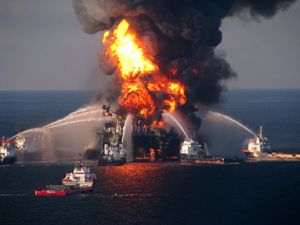
April 20, 2010 | Wellhead blowout.
At 10 p.m. (CT) an explosion and fire occurred on the Deepwater Horizon drilling rig. Eleven people were missing and presumed dead three days later when the search was suspended. A blowout preventer failed to activate.
Image credit: U.S. Coast Guard.
April 21, 2010 | NOAA notified.
At 2:24 a.m. (CT), the U.S. Coast Guard notifies NOAA of the spill. The first oil spill trajectory forecast is issued. Search and rescue efforts continue as the fire still rages.
April 21, 2010 | Preassessment begins.
As soon as news of the spill was received, NOAA and other agencies began working to assess how the oil and other contaminants were impacting natural resources. OR&R staff began mobilizing and coordinating with co-trustees in the field on the preassessment that would later support the Natural Resource Damage Assessment process.
April 22, 2010 | Drilling rig sinks.
At approximately 10:30 a.m. (CT), the Deepwater Horizon drilling rig sank to the bottom of the Gulf of Mexico (~5,000 feet of water).
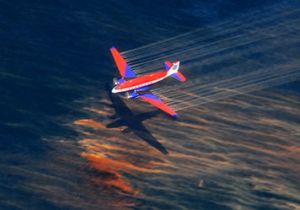
April 22, 2010 | Aerial dispersant operations begin.
Altogether, 1.84 million gallons of dispersants were used, including subsea dispersants. The last aerial dispersant was used on July 19.
Image credit: U.S. Coast Guard.
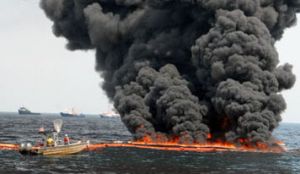
April 28, 2010 | First controlled burn of floating oil.
In total, 411 controlled burns were initiated throughout the response. The last controlled burn was on Aug. 3, 2010.
Image credit: U.S. Coast Guard.
April 28, 2010 | First fishery closures in state waters.
NOAA initiated the first fisheries closures in federal waters four days later and by June 21 closures covered approximately 37% of the Gulf of Mexico.
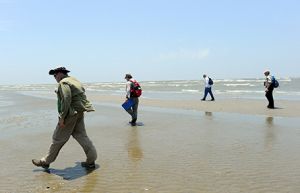
April 30, 2010 | SCAT Program approved.
Teams start systematic aerial and ground surveys of affected shorelines.
May 2, 2010 | Relief well.
BP started drilling a relief well alongside the failed well. An additional 30 vessels and 1,000 responders were deployed to the Gulf Coast. A second relief well was started on May 16.
May 6, 2010 | Containment domes.
From May 6 to May 8, three containment domes designed to collect most of the oil are deployed and then removed due to hydrate buildup making them ineffective.
May 15, 2010 | Oil siphoning.
On May 15 and May 16, BP inserts pipe in riser to siphon off some of the spilling oil to be collected on a vessel on the surface.
May 22, 2010 | National Commission announced.
President Barack Obama announced the creation of the bipartisan National Commission on the BP Deepwater Horizon Oil Spill and Offshore Drilling.
May 26, 2010 | Top kill and junk shot.
From May 26 to May 28, BP pumped thousands of barrels of mud into the well in an attempt to plug the leak, a procedure known in the industry as a “top kill.” The procedure was unsuccessful.
Image credit: BP.
May 30, 2010 | Moratorium on Gulf drilling.
A six-month moratorium is issued on all drilling at a water depth of more than 500 feet in the Gulf of Mexico and the Pacific Ocean.
June 1, 2010 | Third containment attempt.
From June 1 to June 10, BP begins its third attempt to contain the oil from the leaking well using a Lower Marine Riser Package (LMRP) Cap Containment System; oil continues to leak from the Top Cap and make its way to the surface.
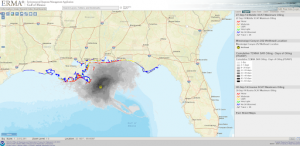
June 5, 2010 | A common operational picture.
ERMA (Environmental Response Management Application) becomes Common Operational Picture (COP) and is released to the public a week later.
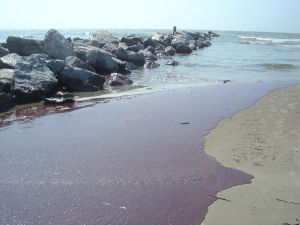
June 6, 2010 | Reaching the shores.
Tests confirmed that tarballs from the Deepwater had washed ashore in all five Gulf states.
July 10, 2010 | New containment cap stops the leak.
From July 10 to July 15, BP installed a new “capping stack” (a containment cap) with a tighter seal than the previous containment cap). At 2:25 p.m. (CT) on July 15, BP closes the valves on the cap and stops the oil leaking out of the riser.
August 2, 2010 | Static kill begins.
BP attempted to stop the flow of oil with a “static kill,” which involved pumping heavy drilling fluid, mud, and cement into the well. The operation was successful, though more work was required to permanently seal the well.
Image credit: BP.
August 16, 2010 | Last NOAA trajectory forecast issued.
In total, 609 trajectory forecasts were issued during the response.
September 13, 2010 | Restoration planning begins.
Trustees release a Notice of Intent to Conduct Restoration Planning.
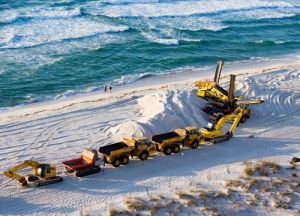
September 19, 2010 | Well officially sealed, cleanup continues.
BP confirmed that well kill operations on the MC252 well in the Gulf of Mexico are now complete, with both the casing and annulus of the well sealed by cement.
January 11, 2011 | Presidential commission releases final report.
The presidential commission’s final report, “Deep Water: The Gulf Oil Disaster and the Future of Offshore Drilling,” goes public.
February 17, 2011 | Restoration scoping begins.
Notice of Intent to begin restoration scoping and prepare a Programmatic Environmental Impact Statement.
April 21, 2011 | BP provides trustees with $1B for early restoration.
After addressing emergency restoration activities, NOAA and co-trustees negotiated with BP on a $1 billion framework agreement for early restoration.
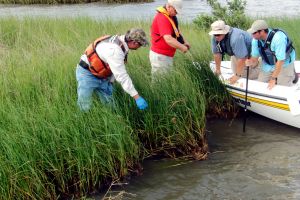
April 14, 2014 | Shoreline assessments completed.
After four years shoreline assessments are completed. Up to 18 SCAT teams operating simultaneously conducted ground surveys of over 4,300 miles of shoreline (over 28,000 miles with repeat surveys).
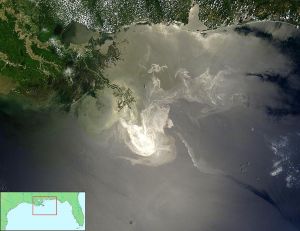
January 15, 2015 | Final spill count - 134 million gallons.
In the Clean Water Act Trial, Judge Barbier determined that 4 million barrels of crude oil were released from the reservoir, of which 3.19 million barrels or approximately 134 million gallons were released into the Gulf of Mexico.
Image credit: NASA.
October 5, 2015 | Draft Restoration Plan released.
Deepwater Horizon trustees release Draft Comprehensive Restoration Plan for the Gulf of Mexico.
February 19, 2016 | Final Damage Assessment and Restoration Plan released.
Final Programmatic Damage Assessment and Restoration Plan and Final Programmatic Environmental Impact Statement released. Record of Decision for the Final Programmatic Damage Assessment and Restoration Plan and Final Programmatic Environmental Impact Statement in March 2016.
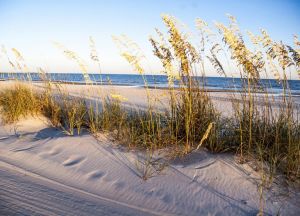
April 4, 2016 | Settlement Gives $8.8B for Natural Resources
BP, the United States, and the five Gulf states agreed to a settlement, or Consent Decree, resolving claims for federal civil penalties and natural resource damages related to the Deepwater Horizon spill. The $20.8 billion settlement, which included up to $8.8 billion for natural resource damages, was the largest environmental damage settlement in U.S. history.
 An official website of the United States government.
An official website of the United States government. 